Telling Bluebell species apart
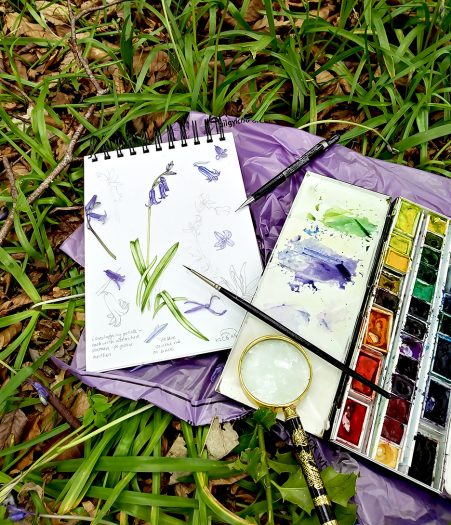
May is Bluebell time!
May is a really wonderful month for botanical illustration; all the spring flowers are in bloom and there’s almost too many subjects to illustrate! I always like to visit our local bluebell woods at this time of year, and thought it might be an idea to write a blog on how you can tell the difference between a native bluebellHyacinthoides non-scripta and a Spanish or garden variety Hyacinthoides hispanica (or a hybrid of the two!)

Native bluebell Hyacinthoides non-scripta
Threats to the Native bluebells from Spanish Bluebell
The iconic British bluebell wood, carpeted with deep purple-blue flowers, is one of the most beautiful sights of the British countryside. However, these flowers are under threat from a variety of sources; climate change, habitat loss, and the presence of the Spanish bluebell. These pretty flowers are more vigorous than our native population, and readily hybridise with them, making a species known as Hyacinthoidesx massartiana. They escape from gardens, and are common across the countryside, and are already firmly established in many bluebell woods. There are fears they may out-compete the native Bluebell. For more on why these Spanish relatives are problematic, please check out the Woodland Trust’s blog.
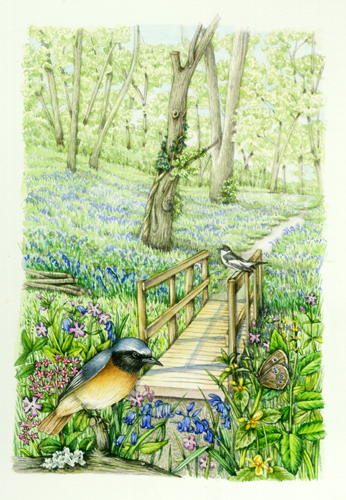
Illustration of a Redstart in a blubell wood in Wales
It’s a good idea to be able to tell these two species apart. However, this can be tricky, especially with the hybrids. Below are a few pointers, gleaned from experts such as Plantlife, the Woodland Trust, Grantham Ecology, and the Wildlife Trusts.
Since writing this blog, the botanist Richard Collingridge has left a helpful comment which is worth looking at before plunging into my species distinctions: “I’m afraid the botany has moved on – your “Spanish” bluebells are in fact hybrids – the hybrid (Hyacinthoides x massartiana) is very variable. The pure Spanish bluebell (H hispanica) may not even occur in the UK at all. Yours are towards the Spanish end of the hybrid’s variability though.
Have a look at this page which summarises the situation very well – it’s written for Cumbria, but I think it applies just as well throughout the UK.” Thanks for the input, Richard.
Leaves
First up, look at the leaves. Both plants have linear, glossy leaves; but the leaves of the Spanish bluebell are markedly broader than those of the native Bluebell. Grantham Ecology suggests a 50 pence test: lay a 50p coin across the leaf. If the coin is broader than the leaf, it’s likely to be a native Bluebell. If the 50p is thinner than the leaf, it’s probably a Spanish bluebell (a 10p coin, also about 1.5cm across, is equally useful). Bear in mind, there’s lots of variation between leaves, even in an individual plant.
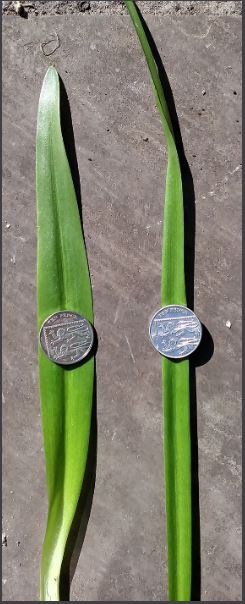
Spanish bluebell (on the left) vs Native bluebell (on the right) and the “coin test”
Smell
Next, take a sniff. Although many say that the Spanish Bluebell doesn’t have a scent, I find this a little misleading as many of the hybrids do, although it may be quite delicate. The native Bluebell does have a stronger perfume, which seems more pronounced in the evenings.
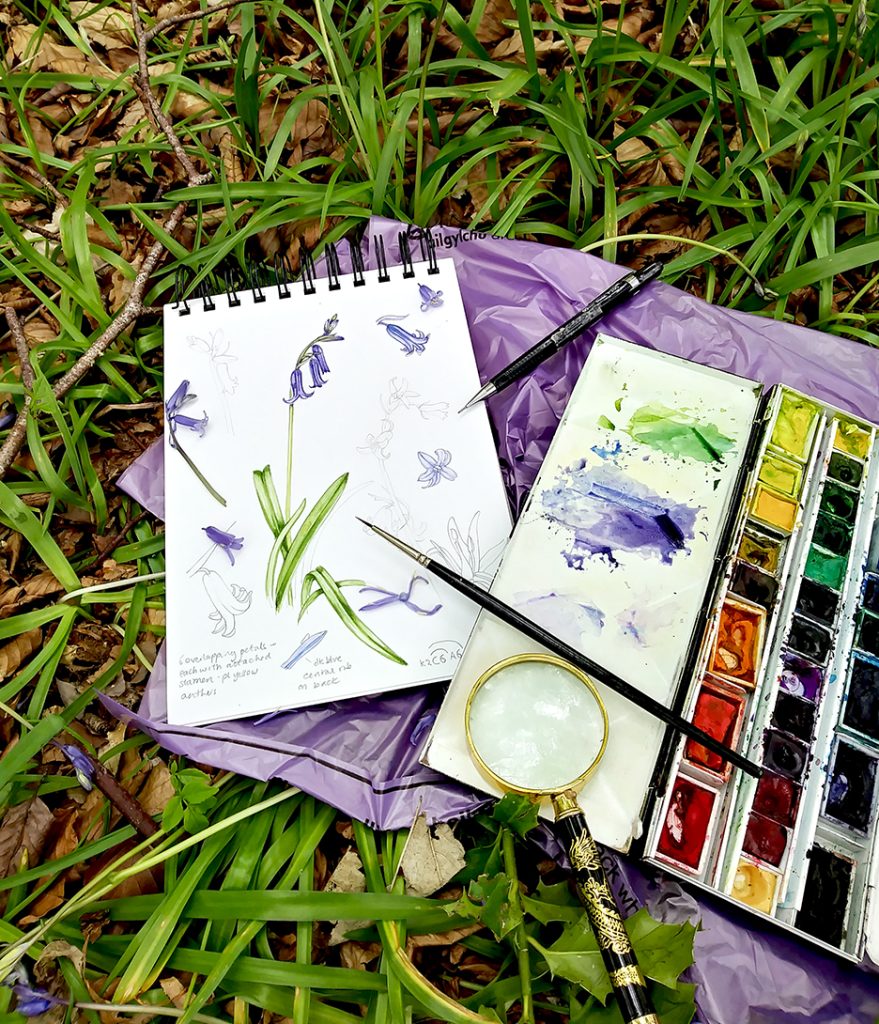
Sketchbook and paintbox out as I studied bluebells in Rook Wood, Hay on Wye
Growth pattern and stems
Moving onto the flowering stems, or racemes, there’s a clear difference. The Spanish bluebells are borne on stouter stems, and these tend to be held upright. Individual flowers appear on both sides of the stem, and don’t tend to droop.
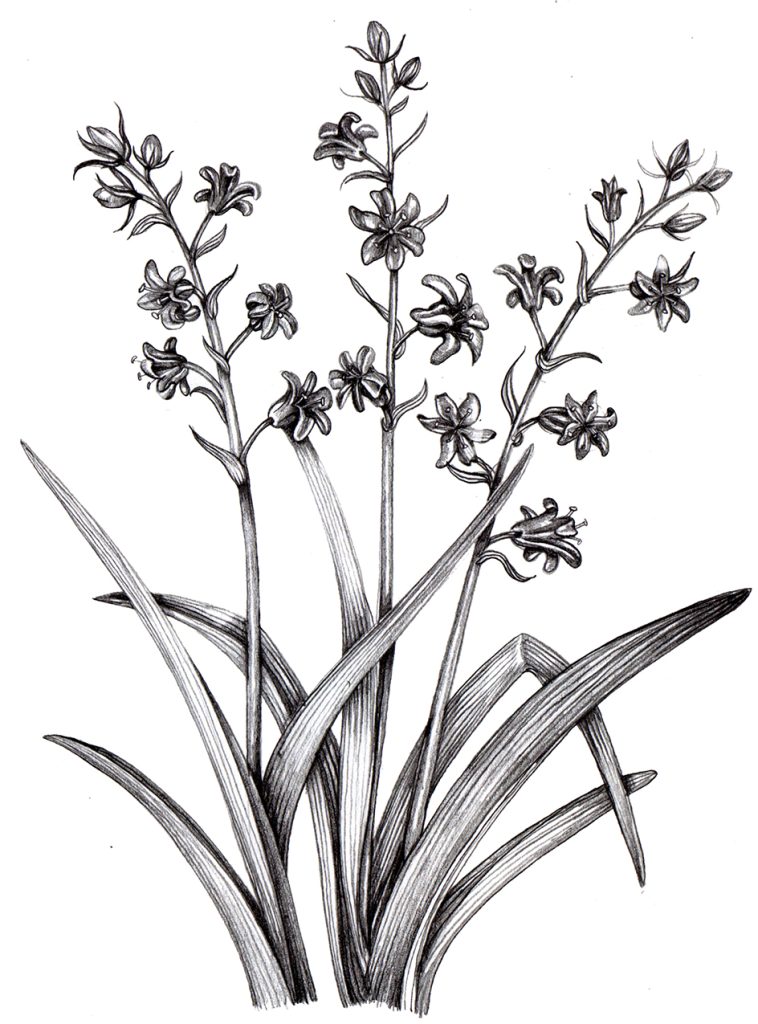
Pencil drawing of a Spanish bluebell, showing the characteristic upright habit and flowers all around the flowering spike
With the native Bluebell, the flowers tend to be on one side of the raceme, with a slender stem, and a markedly drooping habit or growth pattern. These flowering spikes can look very delicate and elegant, and the stems seem to be thinner than the Spanish or hybrid bluebells.

Flowering racemes; the native blubell is the drooping one on the left; the erect one (on the right) with flowers on all sides and less drooping is the Spanish blubell
Hybrids may also bear flowers on a drooping stem, but in general these seem to grown all around the stem, not just on one side. They’re frequently paler than the native bluebell.
Individual flowers
Look at one flower in detail. First, there’s the colour to consider. The native bluebell is a dark purplish blue, paler toward the petal tips, and with a deeper purplish area at the centre of each petal. In the centre of this region, the native bluebell shows a very thin line of a greener blue which runs to the tip of each petal.
In shape it’s a tight tube with parallel sides.
Each flower comprises six fused petals, and the tips of these curve strongly back on themselves (they are recurved). These curled petals are very pronounced, and will often make a full circle, touching the corolla tube or base of the petal tip.
Hybrids rarely have such tightly curved petal tips, and the sides of the corolla tube tend to flare out to make a wider bell-shape than the native flowers do.
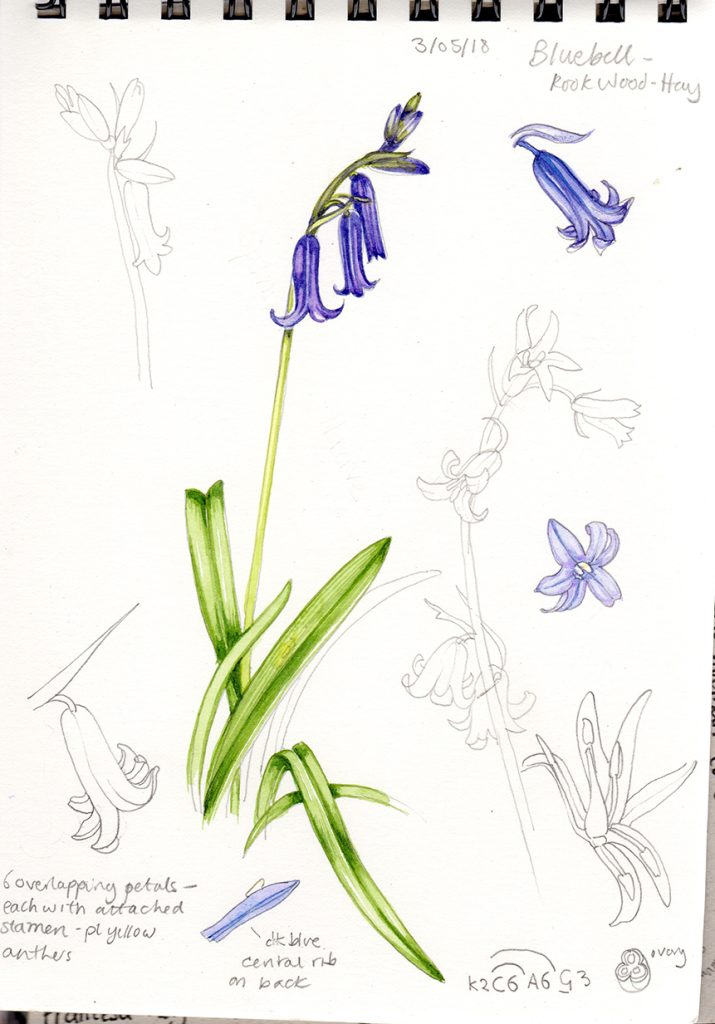
Sketchbook page with studies showing the colour and strongly recurved petals of the native bluebell
The Spanish bluebell tends to be a far paler blue, with a less purple hue. They also come in white and pink (do be aware that the native Bluebell does occasionally put up white forms; these can be told by other diagnostic features rather than by colour). Spanish and hybrids also have six curved petals, but these are far less recurved than the native species.
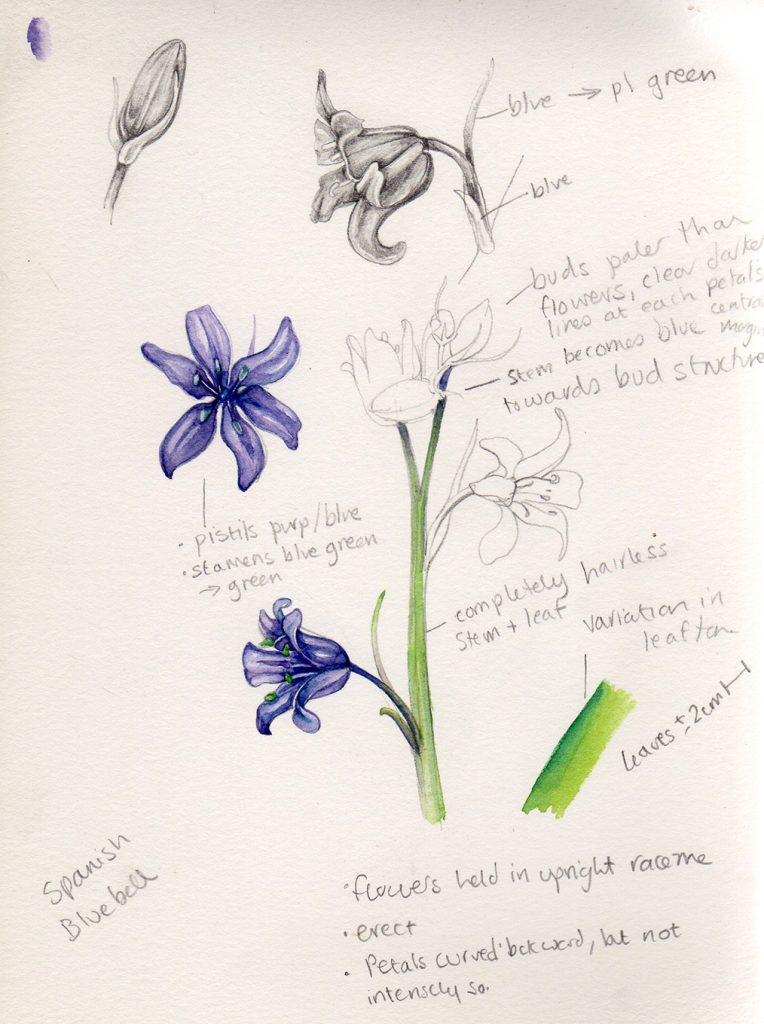
Sketchbook page showing Spanish bluebell flowers which are wider and less recurved
Seeing the two flowers together, it’s clear how different they look. However, when they’re not side by side, and when hybrids abound, it can be tricky to untangle these differences. Hybrids tend to show a variety of characteristics from both species. The flowers below are from Spanish (on the right) and native Bluebells (on the left), and are not hybrids.
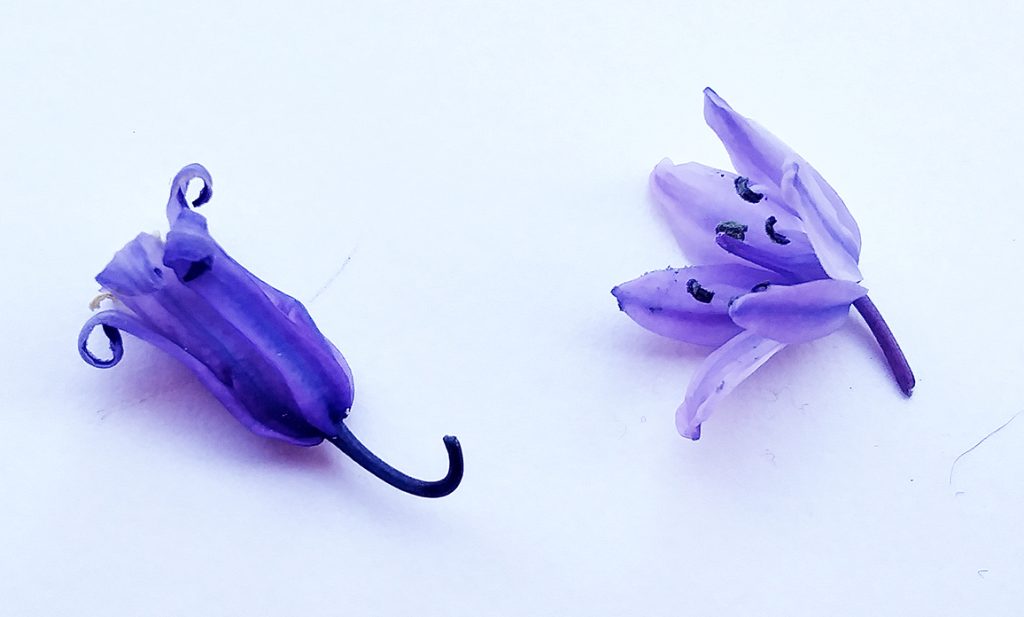
Comparison of the native bluebell (on the left) and Spanish bluebell (on the right)
Stamens
Another difference between the two is the stamen colour (well, the colour of the pollen the stamens produce). In the native bluebell the anthers are a creamy yellow, or white. In the Spanish bluebell they are blueish, dark blue, or greenish. However, be aware of the hybrids; I’ve often seen plants that seem to tick all the boxes for the Spanish bluebell characteristics, but which have pale anthers.
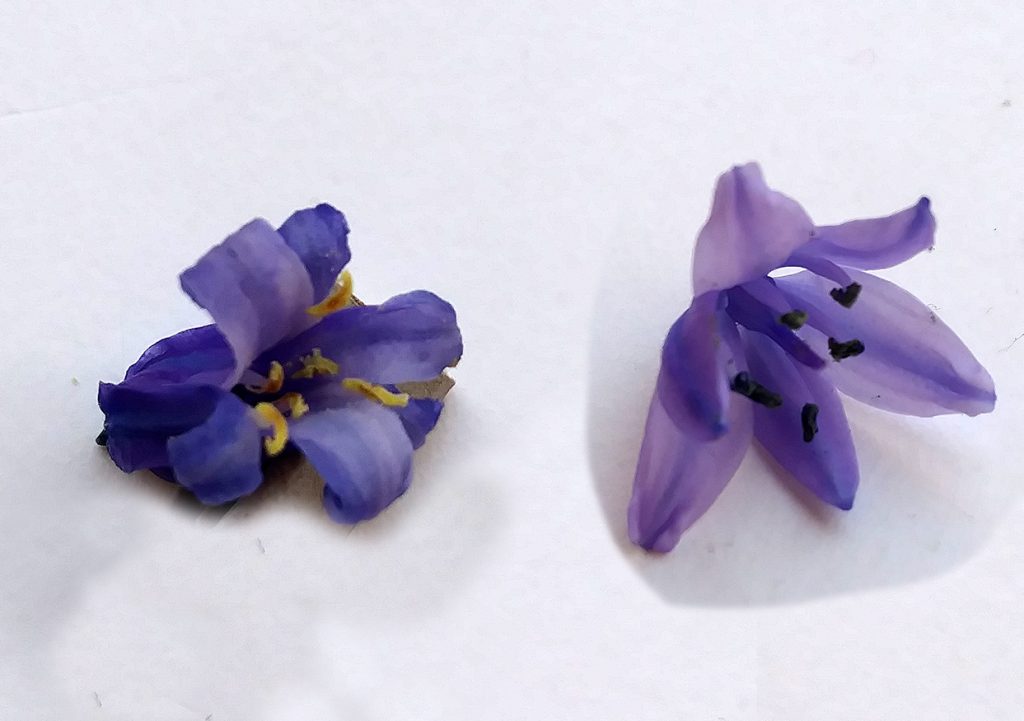
Anthers of the native bluebell (on the left) are pale cream; the Spanish blubell flower (on the right) has dark blue or greenish anthers.
Conclusion
Telling the Spanish and the native bluebell apart is pretty straight forward. A quick look at leaf width, growth form, flower colour and shape and stamens will give you a secure identification.
The trickier part is telling the difference between the Spanish/Native hybrid Hyacinthoidesx massartiana and the native plant. Berks, Bucks and Oxon Wildlife Trust have a good rule of thumb. If you can see ANY of the diagnostic features associated with the Spanish bluebell in your plant, then you’ve got a hybrid on your hands. Simple.
Now get out into your local woods and see how many of those plants are native, and how many are hybrids. Our local bluebell wood has plenty of both; it’s useful to be able to tell them apart.
Below is a film of me creating my bluebell sketch in Rook Wood, near Hay on Wye.


Thanks for the article – now I know the difference. Great illustrations too.
Hi Robert, I know, once you know how it’s easy! Unless you get foxed by hybrids, of course….
Thanks for the comment!
Yours
Lizzie
Beautiful work as always Lizzie ! It’s so lovely to take a peek into your sketchbook too.
This is a brilliant description of the differences between the Bluebell species and I love the final note – if it has any of the features of the Spanish Bluebell, it’s a hybrid ! Good to keep things simple.
That’s down to whatever website I was doing research with. And yes, hybrids are so annoying, best to err on the side of caution eh? Thanks Polly. Hope all is good with you. x
This is very interesting, I have some kind of bluebell in the flower bed if they are Spanish they are out. There’s another bluebell looking plant in the communal area under a tree, the flowers are almost white and they smell of onions! Unpleasant things. Right now I have daffodils in bloom!
Hi Dee
Gosh, thats all terribly early! I should imagine your wite flowers might be wild garlic or similar; a lot of the bulbs are monocots with those distinctive long strap-like leaves with parallel veins. And many are relatives of the onion or Alium family, which may explain the smell. if they are wild garlic then they’re really tasty to eat 0 both in salads, as a steamed green vegetable, or in a pesto.
Its troubling that the seasons are confusing flowering times so much – there are big questions about whether or not insects can synch their life cycles and thus ensure both pollination and their survival. Most garden bluebell species are indeed Spanish ones, so I reckon you’ve called that right.
X
Beautiful paintings and drawings!
However I’m afraid the botany has moved on – your “Spanish” bluebells are in fact hybrids – the hybrid (Hyacinthoides x massartiana) is very variable. The pure Spanish bluebell (H hispanica) may not even occur in the UK at all. Yours are towards the Spanish end of the hybrid’s variability though.
Have a look at this page which summarises the situation very well – it’s written for Cumbria, but I think it applies just as well throughout the UK:
http://www.cumbriabotany.co.uk/look-out-for/bluebells/
Richard – you absolute star! I really appreciate this input and will put a link to the page you suggest. Id not even heard of the pure Spanish bluebell, which just goes to show how easily one can get misled in the tangles world in hybrids and invasives. I very much appreciate you untangling me! Thankyou for taking the time. X
Does anyone know…if you crush the leaves while it’s in the early stages of blooming, say right now, will it still continue to grow? I have a massive amount where my horses are and they are extremely toxic to livestock. I can’t dig them up, they are actually coming up under six inches of gravel….wondering if I can stop the growth by just crushing leaves. Thanks for any advice.
Hi Sharon
Oh man, that sounds like a real problem! Plants sometimes just won’t be stopped. Destroying the leaves will definitely weaken the plant, but wont kill it. I wonder who chose to set up a place for horses in the middle of some toxic plants? I also think in the UK bluebells (the native ones) are a protected species, so getting rid of them could be a problem for that reason too…. I’m so sorry I’ve not got any more constructive response for you, I can see that’s a real nightmare! Could you possibly have a chat with the land-owner and pass the buck on to them? (That’s assuming you’re not the land-owner yourself…) Oh poor you, and your poor horses. Ho[pe you manage to sort things out soon. x
This is the best article I’ve ever read about the differences between English and Spanish bluebells. I feel far more confident now to be able to tell the difference. Thank you so much for such brilliant illustrations, information and images.
Wow Penny, that is such high praise! I really appreciate it! So glad to help.